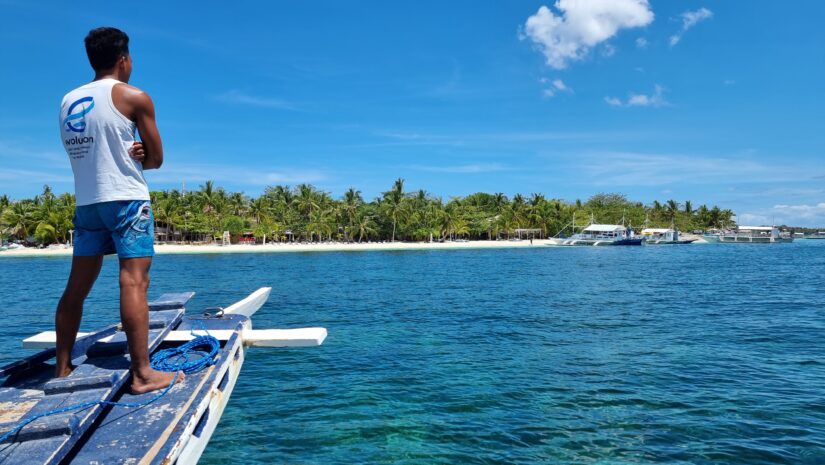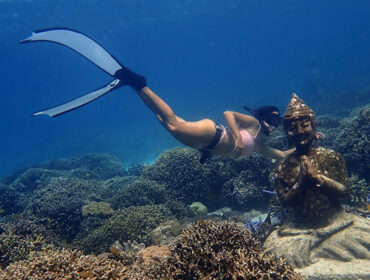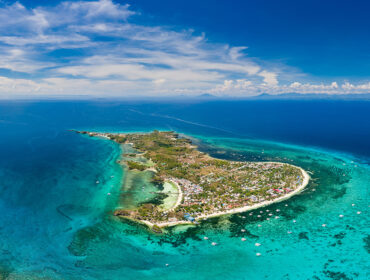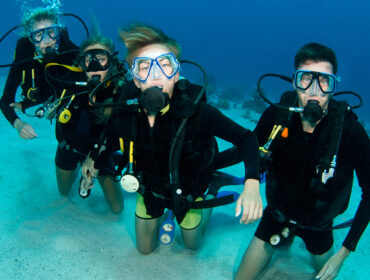Malapascua Island in Northern Cebu houses thresher sharks, often found in the deep ocean. They make rare visits to the island’s shallow cleaning stations where they engage in parasite removal. These interactions, observable by humans at only a few locations worldwide, reveal the ecological significance of thresher sharks.
People who have experienced diving with thresher sharks are part of a select group, witnessing an uncommonly seen natural phenomenon. The privilege of observing them in their habitat just shows the importance of conservation efforts to protect them and their ecosystems.
One place we can see these sharks is off the coast of Malapascua Island in the Philippines. However, if current activity trends continue, their presence may not last much longer.
What to do in Malapascua Island?
On the small tropical island of Malapascua in the Philippines, divers are drawn to Monad Shoal and Kimud Shoal. Both are renowned for consistent thresher shark sightings. Although sightings at Monad Shoal have dwindled, Kimud Shoal consistently offers encounters with several sharks each morning.
Diving with thresher sharks and seeing how they navigate the clear waters is both a humbling and exhilarating experience. I’ve gained insight into the underwater lives of these elusive predators. Thresher sharks, recognized for their distinctively long tails used to stun prey, are a rare sight globally. Thankfully, they can be observed more commonly in the shallow waters of Kimud Shoal.
The Dive Process at Kimud Shoal
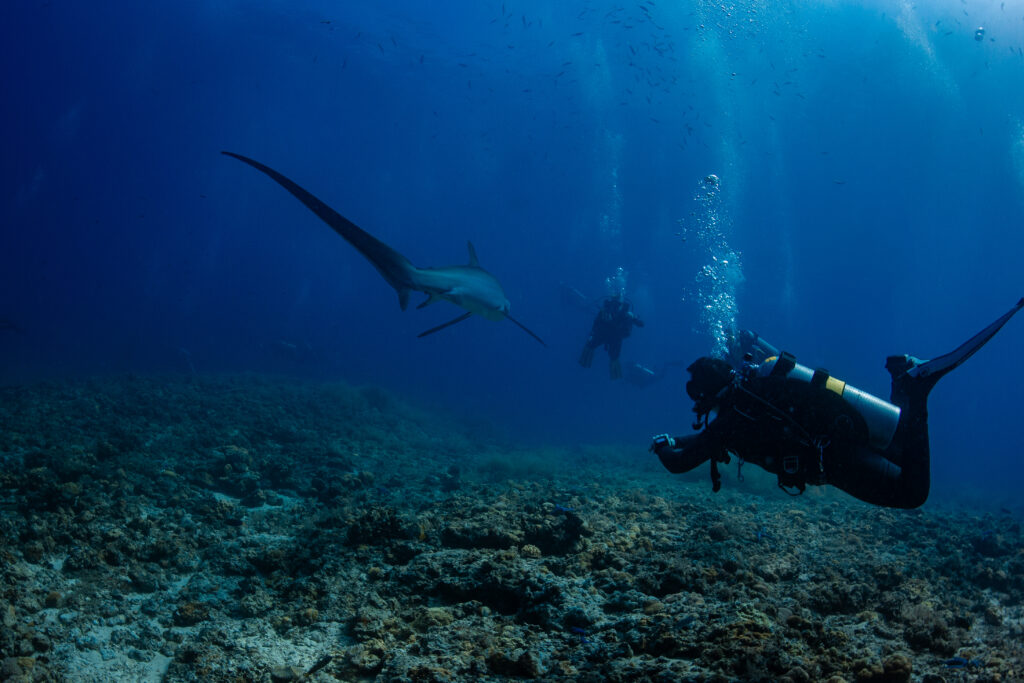
Seeing the thresher sharks at Kimud stars early, as divers get briefed at 4:15 AM and embark by 4:30 AM. The journey to the site involves a 50-minute boat ride, arriving just after sunrise when the sharks are most observed. Each morning includes two dives, allowing divers ample opportunity to encounter these elusive creatures in their natural habitat.
Descending from the boat into the serene, early morning waters of the dive site, divers move across the reef. The vibrant colors and bustling marine life provide a stunning backdrop. The anticipation heightens as you approach the edge of the drop-off. Looking down, you can see that the reef gives way to the deep blue abyss. Your eyes scan the darkness, waiting for the elusive thresher sharks to emerge. The underwater silence is punctuated by the soft sounds of your breathing. And then, out of the blue, a thresher shark gracefully appears. Its long, whip-like tail moves rhythmically. It glides effortlessly through the water, often heading towards a cleaning station swarming with smaller fish.
The sight is mesmerizing, a reminder of the ocean’s wonders and the delicate balance of its ecosystems. The sense of connection with such an ancient and elusive creature is strong. It leaves divers with a lasting appreciation for the delicate balance of Malapascua Island and the need for its conservation.
Protecting Kimud Shoal Dive Sites
The conservation of sites like Kimud Shoal in Malapascua Island is essential. The threats of warming oceans, harmful fishing practices, and unsustainable tourism activities pose risks to thresher sharks. And not just them, but also the broader marine biodiversity. Unfortunately, the impacts of these threats are already being seen by divers at this special site.
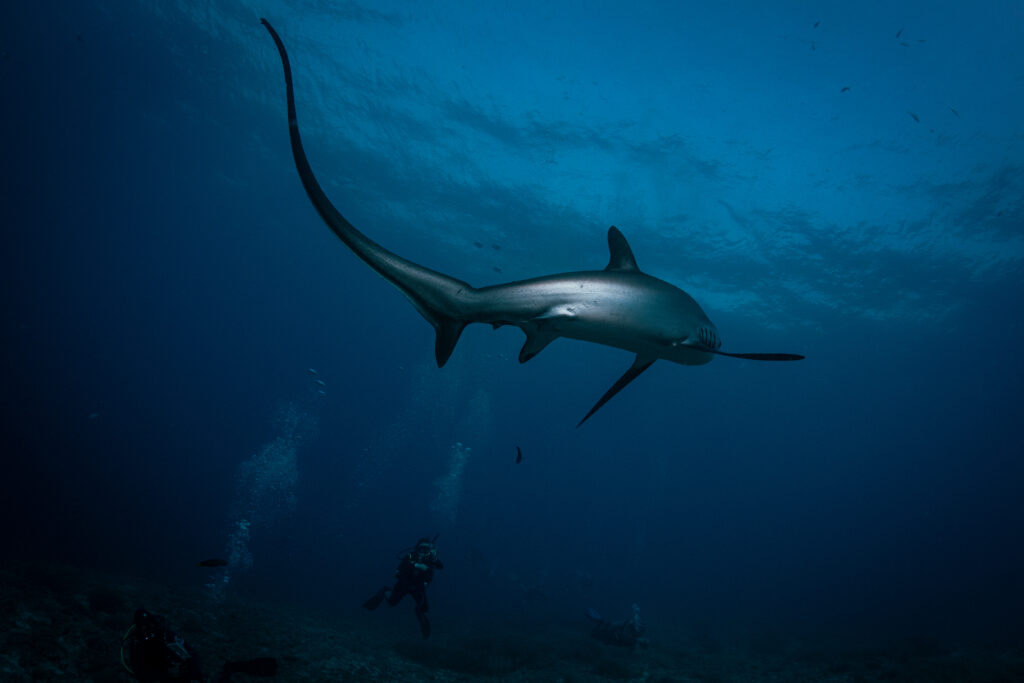
From inexperienced divers violating the coral to the ongoing threat of coral bleaching, these harmful activities endanger thresher sharks. These reefs host cleaner fish that are crucial for the sharks’ health, forming a complex ecosystem. So complex that the loss of any single element could lead to a broader ecological collapse. If these detrimental activities continue, we risk losing the sharks and the intricate balance of the entire marine ecosystem.
It is crucial for divers visiting Malapascua Island to opt for environmentally conscious dive operators like Evolution Diving. They are committed to sustainable practices and minimize human impact on these fragile ecosystems. This conserves the marine environment and supports local businesses that actively protect these magnificent sharks.
Scientific Studies Regarding Pelagic Thresher Sharks
Scientific research on pelagic thresher sharks has significantly expanded our understanding of these majestic marine predators. Studies have focused on their unique hunting techniques. They hunt by the use of their elongated tail fin, which they use to whip the water to stun prey. Research has also delved into their migratory patterns, revealing extensive movements across oceanic waters, which are critical for conservation efforts. Genetic analyses have provided insights into their population structure and connectivity between different regions. Additionally, tagging and tracking studies have shed light on their depth preferences and vertical movement patterns. Each of their traits highlight their adaptation to a wide range of oceanic environments.
This research, sadly, has also shown us alarming insights into the catch composition of pelagic thresher sharks. Recent studies in Indonesia find that a staggering 80% of thresher sharks caught by local fishermen were pregnant females. Removing pregnant females from the population can severely impact the species’ reproductive potential and long-term viability. Pelagic thresher sharks are already vulnerable due to their late maturity, low fecundity, and long gestation period.
Make Every Dive Count
Divers visiting sites like this one have a unique opportunity to contribute valuable data to citizen science projects. They can log their observations and aid in filling critical data gaps in this part of the world. Divers should record not only sightings of thresher sharks but also absences. Noting absences is important since they indicate shifts in their population or behavior. Detailed observations should include:
- Number of sharks seen
- Any identifiable features
- Their behavior
- Any notable interactions, such as cleaning sessions at the reef
Additionally, divers should assess the condition of the reef, noting the health of the corals and any signs of damage. Such comprehensive data collection provides insights into the overall health of the ecosystem and the dynamics of thresher shark populations. This information is invaluable for marine biologists and conservationists, helping protect strategies and ensure the sustainability of these critical habitats.
There are user-friendly mobile apps that teach you how to collect data and record it. This allows anyone to upload their observations as soon as they’re back on land and connected to data or Wi-Fi. Accessible data submissions for drivers, yay!
Natural Light Photography: Photographing Thresher Sharks
Sharks are a captivating species to photograph, but there is something uniquely enchanting about thresher sharks.
Photographers must rely solely on natural lighting to capture images of thresher sharks at Kimud Shoal. The use of artificial lighting is strictly prohibited due to the sharks’ light-sensitive eyes, which are accustomed to the deep dark ocean.
However, if you have to photograph them, go in the morning. The clear visibility and the ethereal morning light highlight the sharks’ sleek, silver bodies and their elongated tail fins. And remember, patience and a steady hand are essential! The thresher sharks’ sudden bursts of speed demand quick reflexes and precise timing to capture the perfect shot.
A good tip for capturing excellent photos and videos of thresher sharks is to spend some time understanding their behavior. Watch their interactions with the schools of cleaner fish and try to anticipate their next move. You’ll notice they typically follow a figure-eight pattern through the schools, often returning at a slightly different angle. By studying their movements, you can position yourself perfectly to capture stunning shots.
Leverage the natural light — early morning light is soft and can create beautiful lighting effects if used correctly. Position yourself with the sun behind you to illuminate the shark. Also, be mindful of the sun’s angle and how it interacts with the water. Maintain a low position in the water, ensuring excellent buoyancy to avoid touching the delicate reef they rely on. Lastly, keep all your gear close to you to minimize disturbance to the environment.
This unique opportunity to photograph thresher sharks in their natural habitat makes Kimud Shoal a bucket-list destination for underwater photographers.
Securing Malapascua Island

Protecting sites like Kimud Shoal is crucial for the survival of thresher sharks, as well as the broader marine ecosystem. These reefs provide habitats and cleaning stations critical for the sharks’ wellbeing, allowing them to tend to their daily needs. The unique opportunity to witness these behaviors is a privilege afforded to divers at very few places in the world. Thus, this highlights the global significance of such sites.
Diving with thresher sharks in the Philippines is a captivating experience and a call to action for marine conservation. Divers need to choose eco-conscious dive operators and participate responsibly in maintaining the delicate balance of marine ecosystems. Through working together, we can help ensure the preservation of these majestic creatures and their habitats for generations to come.

